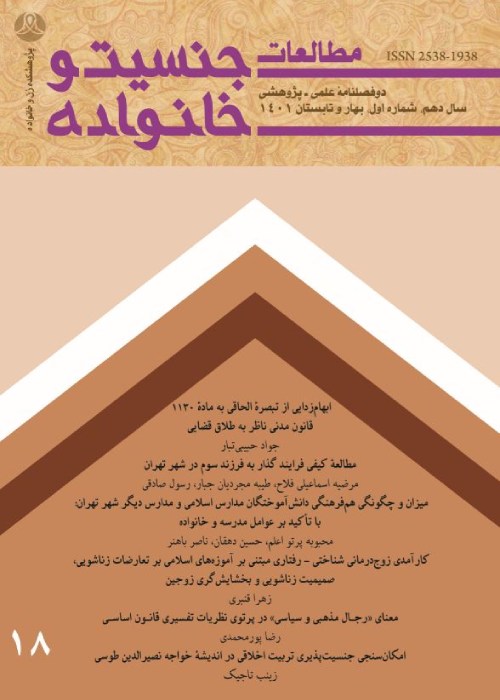Differences in Shiite-Sunni’s Gender Attitude in Iran
Author(s):
Article Type:
Research/Original Article (دارای رتبه معتبر)
Abstract:
The main purpose of this study is to examine the relationship between religious identity and gender attitude. Moreover, to have a better understanding, the research evidence also provides some of the most important patterns and determinants relevant to Shiite and Sunni's gender attitudes. The data are based on the analysis of a survey with a sample population of 4267 men and women aged 15 and over, living in urban and rural districts of Esfarain, Ahvaz, Babolsar, Bojnourd, Khorramabad, Saqez, Kamyaran, Gonbad Kavous, Mahmoudabad and Hamedan. According to the preliminary results of this study, it can be said that in most of the gendered aspects of the research, the attitudeof the both Shiite and Sunni groups is more or less similar. At the same time, the highest level of difference between Shiite and Sunni groups is obviously visible in their attitude toward women's employment outside home: about 72 percent of the Shiite population and about 65 percent of the Sunni population have a positive attitude toward female employment. Nevertheless, gender attitudes are more influenced by gender variable rather than being influenced by religion and religious affiliation. That is, Shiite and Sunni women have a similarly positive attitude toward these gendered components and aspects more than their male counterparts; for example, 80 percent of Shiite women and 74 percent of Shiite women have a positive attitude toward female employment, while this ratio is much lower than their male counterparts (64 percent and 56 percent, respectively). In addition, these general patterns of religious groups’ attitudes toward gender are under the influence of two categories of variables including basic demographic variables (place of residence, marital status, and age and education status) as well as including variables related to the components of religion and religiosity. To sum up, the results of the present study can be summarized and explained in a way that religious and religious affiliations act as a secondary element in explaining gender attitudes. It also reveals that the level of economic and social development as well as the realities of everyday life play a far more remarkable role, especially the decisive role of variables such as rural versus urbanization, traditionalism and illiteracy versus modernism and modernization, and higher education.
Keywords:
Language:
Persian
Published:
Journal of Gender and Family Studies, Volume:6 Issue: 2, 2019
Pages:
125 to 156
magiran.com/p2212375
دانلود و مطالعه متن این مقاله با یکی از روشهای زیر امکان پذیر است:
اشتراک شخصی
با عضویت و پرداخت آنلاین حق اشتراک یکساله به مبلغ 1,390,000ريال میتوانید 70 عنوان مطلب دانلود کنید!
اشتراک سازمانی
به کتابخانه دانشگاه یا محل کار خود پیشنهاد کنید تا اشتراک سازمانی این پایگاه را برای دسترسی نامحدود همه کاربران به متن مطالب تهیه نمایند!
توجه!
- حق عضویت دریافتی صرف حمایت از نشریات عضو و نگهداری، تکمیل و توسعه مگیران میشود.
- پرداخت حق اشتراک و دانلود مقالات اجازه بازنشر آن در سایر رسانههای چاپی و دیجیتال را به کاربر نمیدهد.
In order to view content subscription is required
Personal subscription
Subscribe magiran.com for 70 € euros via PayPal and download 70 articles during a year.
Organization subscription
Please contact us to subscribe your university or library for unlimited access!



